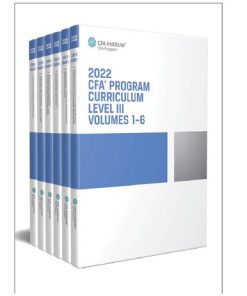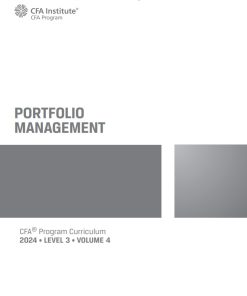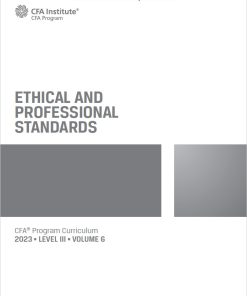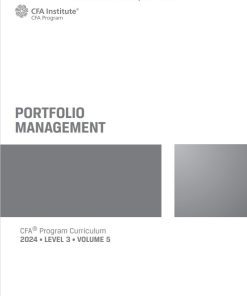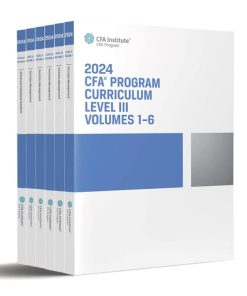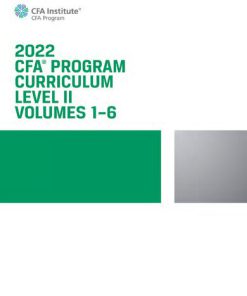2022 CFA Program Curriculum Level III Box Set vol 1 6 1st Edition by Cfa Institute ISBN 9781950157624 1950157628
$50.00 Original price was: $50.00.$25.00Current price is: $25.00.
2022 CFA Program Curriculum Level III Box Set vol 1 6 1st Edition by Cfa Institute – Ebook PDF Instant Download/Delivery: 9781950157624 ,1950157628
Full download 2022 CFA Program Curriculum Level III Box Set vol 1 6 1st Edition after payment
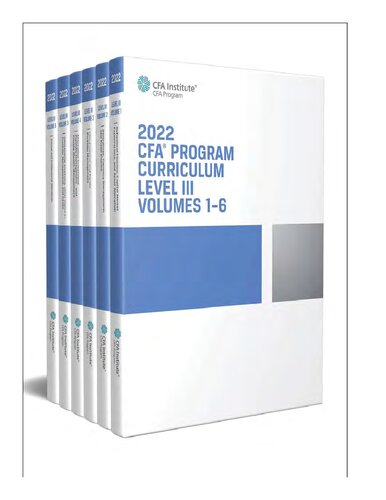
Product details:
ISBN 10: 1950157628
ISBN 13: 9781950157624
Author: Cfa Institute
Prepare for success on the 2022 CFA Level III exam with the latest official CFA® Program Curriculum.
The 2022 CFA Program Curriculum Level III Box Set contains all the material you need to succeed on the Level III CFA exam in 2022. This set includes the full official curriculum for Level III and is part of the larger CFA Candidate Body of Knowledge (CBOK).
Designed to acclimate you to the exam’s heavy reliance on information synthesis and solution application regarding portfolio management and wealth planning, the Level III curriculum will help you master both calculation-based and word-based problems.
Highly visual and intuitively organized, this box set allows you to:
- Learn from financial thought leaders.
- Access market-relevant instruction.
- Gain critical knowledge and skills.
The set also includes practice questions to assist with your recall of key terms, concepts, and formulas.
Perfect for anyone preparing for the 2022 Level III CFA exam, the 2022 CFA Program Curriculum Level III Box Set is a must-have resource for those seeking the advanced skills required to become a Chartered Financial Analyst®.
2022 CFA Program Curriculum Level III Box Set vol 1 6 1st Edition Table of contents:
Reading 1. The Behavioral Biases of Individuals1. Introduction and Categorizations of Behavioral Biases
1.1. Categorizations of Behavioral Biases
1.2. Differences between Cognitive Errors and Emotional Biases
2. Cognitive Errors: Belief Perseverance Biases: Conservation Bias and Confirmation Bias
2.1. Belief Perseverance Biases
2.1.1. Conservatism Bias
Consequences of Conservatism Bias
Detection of and Guidance for Overcoming Conservatism Bias
2.1.2. Confirmation Bias
Consequences of Confirmation Bias
Detection of and Guidance for Overcoming Confirmation Bias
3. Cognitive Errors: Belief Perseverance Biases – Representativeness
3.1. Base-Rate Neglect
3.2. Sample-Size Neglect
3.3. Consequences of Representativeness Bias
3.4. Detection of and Guidance on Overcoming Representativeness Bias
4. Cognitive Errors: Belief Perseverance Biases – Illusion of Control Bias and Hindsight Bias
4.1. Illusion of control bias
Consequences of Illusion of Control
Detection of and Guidelines for Overcoming Illusion of Control Bias
4.2. Hindsight Bias
Consequences of Hindsight Bias
Detection of and Guidelines for Overcoming Hindsight Bias
5. Cognitive Errors: Information Processing Biases
5.1. Anchoring and Adjustment Bias
Consequences of Anchoring and Adjustment Bias
Detection of and Guidelines for Overcoming Anchoring and Adjustment Bias
5.2. Mental Accounting Bias
Consequences of Mental Accounting Bias
Detection of and Guidelines for Overcoming Mental Accounting Bias
5.3. Framing Bias
Consequences of Framing Bias
Detection of and Guidelines for Overcoming Framing Bias
5.4. Availability Bias
Retrievability
Categorization
Narrow Range of Experience
Resonance
Consequences of Availability Bias
Detection of and Guidelines for Overcoming Availability Bias
5.5. Cognitive Errors: Conclusion
6. Emotional Biases: Loss Aversion
6.1. Loss-Aversion Bias
Consequences of Loss Aversion
Special Application: Myopic Loss Aversion
Detection of and Guidelines for Overcoming Loss Aversion
7. Emotional Biases: Overconfidence & Self Control
7.1. Overconfidence Bias
Consequences of Overconfidence Bias
Detection of and Guidelines for Overcoming Overconfidence Bias
7.2. Self-Control Bias
Consequences of Self-Control Bias
Detection of and Guidelines for Overcoming Self-Control Bias
8. Emotional Biases: Status Quo, Endowment, and Regret-Aversion
8.1. Status Quo Bias
Consequences of Status Quo Bias
Detection of and Guidelines for Overcoming Status Quo Bias
8.2. Endowment Bias
Consequences of Endowment Bias
Detection of and Guidelines for Overcoming Endowment Bias
8.3. Regret-Aversion Bias
Consequences of Regret-Aversion Bias
Detection of and Guidelines for Overcoming Regret-Aversion Bias
8.4. Emotional Biases: Conclusion
Summary
References
Practice Problems
Solutions
Reading 2. Behavioral Finance and Investment Processes
Learning Outcomes
1. Introduction and General Discussion of Investor Types
1.1. General Discussion of Investor Types
1.1.1. Barnewall Two-Way Model
1.1.2. Bailard, Biehl, and Kaiser Five-Way Model
2. New Developments in Psychographic Modeling: Behavioral Investor Types
2.1. The Behavioral Alpha Process: A Top-Down Approach
Step 1: Interview the client and identify active or passive traits and risk tolerance.
Step 2: Plot the investor on the active/passive and risk tolerance scale.
Step 3: Test for behavioral biases.
Step 4: Classify investor into a behavioral investor type.
Advising Passive Preservers:
Advising Friendly Followers:
Advising Independent Individualists:
Advising Active Accumulators:
2.2. Limitations of Classifying Investors into Various Types
3. How Behavioral Factors Affect Adviser-Client Relations
3.1. Formulating Financial Goals
3.2. Maintaining a Consistent Approach
3.3. Investing as the Client Expects
3.4. Ensuring Mutual Benefits
3.5. Limitations of Traditional Risk Tolerance Questionnaires
4. How Behavioral Factors Affect Portfolio Construction
4.1. Inertia and Default
4.2. Naïve Diversification
4.3. Company Stock: Investing in the Familiar
4.4. Excessive Trading
4.5. Home Bias
4.6. Behavioral Portfolio Theory
5. Behavioral Finance and Analyst Forecasts and Overconfidence in Forecasting Skills
5.1. Overconfidence in Forecasting Skills
5.1.1. Remedial Actions for Overconfidence and Related Biases
6. Influence of Company’s Management on Analysis and Analyst Biases in Conducting Research
6.1. Remedial Actions for Influence of Company’s Management on Analysis
6.2. Analyst Biases in Conducting Research
6.3. Remedial Actions for Analyst Biases in Conducting Research
7. How Behavioral Factors Affect Committee Decision Making
7.1. Investment Committee Dynamics
7.2. Techniques for Structuring and Operating Committees to Address Behavioral Factors
8. How Behavioral Finance Influences Market Behavior
8.1. Defining Market Anomalies
8.2. Momentum
8.3. Bubbles and Crashes
8.4. Value and Growth
Summary
References
Practice Problems
Solutions
Study Session 2. Capital Market Expectations
Reading Assignments
Reading 3. Capital Market Expectations, Part 1: Framework and Macro Considerations
Learning Outcomes
1. Introduction & Framework for Developing Capital Market Expectations
1.1. Framework and Challenges
1.1.1. A Framework for Developing Capital Market Expectations
2. Challenges in Forecasting
2.1. Limitations of Economic Data
2.2. Data Measurement Errors and Biases
2.3. The Limitations of Historical Estimates
2.4. Ex Post Risk Can Be a Biased Measure of Ex Ante Risk
2.5. Biases in Analysts’ Methods
2.6. The Failure to Account for Conditioning Information
2.7. Misinterpretation of Correlations
2.8. Psychological Biases
2.9. Model Uncertainty
3. Economic and Market Analysis: The Role of Economic Analysis and Analysis of Economic Growth: Exogenous Shocks to Growth
3.1. The Role of Economic Analysis
3.2. Analysis of Economic Growth
3.2.1. Exogenous Shocks to Growth
4. Applying Growth Analysis to Capital Market Expectations
4.1. A Decomposition of GDP Growth and Its Use in Forecasting
4.2. Anchoring Asset Returns to Trend Growth
5. Approaches to Economic Forecasting
5.1. Econometric Modeling
5.2. Economic Indicators
5.3. Checklist Approach
5.4. Economic Forecasting Approaches: Summary of Strengths and Weaknesses
6. Business Cycle Analysis, Phases of the Business Cycle and Market Expectations and the Business Cycle
6.1. Phases of The Business Cycle
6.2. Market Expectations and the Business Cycle
7. Inflation and Deflation: Trends and Relations to the Business Cycle
8. Analysis of Monetary and Fiscal Policies
8.1. Monetary Policy
9. What Happens When Interest Rates Are Zero or Negative? And Implications of Negative Rates for Capital Market Expectations
9.1. Implications of Negative Interest Rates for Capital Market Expectations
10. The Monetary and Fiscal Policy Mix and the Shape of the Yield Curve and the Business Cycle
10.1. The Shape of the Yield Curve and the Business Cycle
11. International Interactions
11.1. Macroeconomic Linkages
11.2. Interest Rate/Exchange Rate Linkages
Summary
References
Practice Problems
Solutions
Reading 4. Capital Market Expectations, Part 2: Forecasting Asset Class Returns
Learning Outcomes
1. Introduction
2. Overview of Tools and Approaches
2.1. The Nature of the Problem
2.2. Approaches to Forecasting
2.2.1. Statistical Methods
2.2.2. Discounted Cash Flow
2.2.3. Risk Premium Models
3. Forecasting Fixed Income Returns
3.1. Applying DCF to Fixed Income
3.2. The Building Block Approach to Fixed-Income Returns
3.2.1. The Short-term Default-free Rate
3.2.2. The Term Premium
3.2.3. The Credit Premium
3.2.4. The Liquidity Premium
4. Risks in Emerging Market Bonds
4.1. Economic Risks/Ability to Pay
4.2. Political and Legal Risks/Willingness to Pay
5. Forecasting Equity Returns
5.1. Historical Statistics Approach to Equity Returns
5.2. DCF Approach to Equity Returns
5.3. Risk Premium Approaches to Equity Returns
5.3.1. Defining and Forecasting the Equity Premium
5.3.2. An Equilibrium Approach
5.4. Risks in Emerging Market Equities
6. Forecasting Real Estate Returns
6.1. Historical Real Estate Returns
6.2. Real Estate Cycles
6.3. Capitalization Rates
6.4. The Risk Premium Perspective on Real Estate Expected Return
6.5. Real Estate in Equilibrium
6.6. Public vs. Private Real Estate
6.7. Long-Term Housing Returns
7. Forecasting Exchange Rates
7.1. Focus on Goods and Services, Trade, and the Current Account
7.1.1. Trade Flows
7.1.2. Purchasing Power Parity
7.1.3. Competitiveness and Sustainability of the Current Account
7.2. Focus on Capital Flows
7.2.1. Implications of Capital Mobility
7.2.2. Uncovered Interest Rate Parity and Hot Money Flows
7.2.3. Portfolio Balance, Portfolio Composition, and Sustainability Issues
8. Forecasting Volatility
8.1. Estimating a Constant VCV Matrix with Sample Statistics
8.2. VCV Matrices from Multi-Factor Models
8.3. Shrinkage Estimation of VCV Matrices
8.4. Estimating Volatility from Smoothed Returns
8.5. Time-Varying Volatility: ARCH Models
9. Adjusting a Global Portfolio
9.1. Macro-Based Recommendations
Trend Growth
Global Integration
Phases of the Business Cycle
Monetary and Fiscal Policies
Current Account Balances
Capital Accounts and Currencies
9.2. Quantifying the Views
Summary
References
Practice Problems
Solutions
Study Session 3. Asset Allocation and Related Decisions in Portfolio Management
Reading Assignments
Reading 5. Overview of Asset Allocation
Learning Outcomes
1. Introduction and Asset Allocation: Importance in Investment Management
1.1. Asset Allocation: Importance in Investment Management
2. The Investment Governance Background to Asset Allocation
2.1. Governance Structures
2.2. Articulating Investment Objectives
2.3. Allocation of Rights and Responsibilities
2.4. Investment Policy Statement
2.5. Asset Allocation and Rebalancing Policy
2.6. Reporting Framework
2.7. The Governance Audit
3. The Economic Balance Sheet and Asset Allocation
4. Approaches to Asset Allocation, Relevant Objectives and Relevant Risk Concepts
4.1. Relevant Objectives
4.2. Relevant Risk Concepts
5. Modeling Asset Class Risk
6. Strategic Asset Allocation
7. Strategic Asset Allocation: Asset Only
8. Strategic Asset Allocation: Liability Relative
9. Strategic Asset Allocation: Goals Based
10. Implementation Choices
10.1. Passive/Active Management of Asset Class Weights
10.2. Passive/Active Management of Allocations to Asset Classes
10.3. Risk Budgeting Perspectives in Asset Allocation and Implementation
11. Rebalancing: Strategic considerations
11.1. A Framework for Rebalancing
11.2. Strategic Considerations in Rebalancing
Summary
References
Practice Problems
Solutions
Reading 6. Principles of Asset Allocation
Learning Outcomes
1. Introduction
2. Developing Asset-Only Asset Allocations; and Mean-Variance Optimization: Overview
2.1. Mean–Variance Optimization: Overview
3. Monte Carlo Simulation
4. Criticisms of Mean-Variance Optimization
5. Addressing the Criticisms of Mean-Variance Optimization; Reverse Optimization and Black Litterman Model
5.1. Reverse Optimization
5.2. Black–Litterman Model
6. Addressing the Criticisms of Mean-Variance Optimization; Adding Constraints beyond Budget Constraints, Resampled Mean-Variance Optimizations and Other Non-Normal Optimization Approaches
6.1. Resampled Mean–Variance Optimization
6.2. Other Non-Normal Optimization Approaches
7. Allocating to Less Liquid Asset Classes
8. Risk Budgeting
9. Factor-Based Asset Allocation
10. Developing Liability-Relative Asset Allocations; and Characterizing the Liabilities
10.1. Characterizing the Liabilities
11. Approaches to Liability-Relative Asset Allocation; and Surplus Optimization
11.1. Surplus Optimization
12. Approaches to Liability-Relative Asset Allocation
12.1. Hedging/Return-Seeking Portfolio Approach
Forming the Hedging Portfolio
Limitations
12.2. Integrated Asset–Liability Approach
12.3. Comparing the Approaches
13. Examining the Robustness of Asset Allocation Alternatives
14. Factor Modeling in Liability-Relative Approaches
15. Developing Goals-Based Asset Allocations. The Goals-Based Asset Allocation Process and Describing Client Goals.
15.1. The Goals-Based Asset Allocation Process
15.2. Describing Client Goals
16. Constructing Sub-Portfolios and the Overall Portfolio
16.1. The Overall Portfolio
17. Revisiting the Module Process in Detail
18. Periodically Revisiting the Overall Asset Allocation and Issues Related to Goals-Based Asset Allocation
18.1. Issues Related to Goals-Based Asset Allocation
19. Heuristics and Other Approaches to Asset Allocation
19.1. The “120 minus your age” rule
19.2. The 60/40 stock/bond heuristic
19.3. The endowment model
19.4. Risk parity
19.5. The 1/N rule
20. Portfolio Rebalancing in Practice
Summary
References
Practice Problems
Solutions
Reading 7. Asset Allocation with Real-World Constraints
Learning Outcomes
1. Introduction
2. Constraints in Asset Allocation and Asset Size
2.1. Asset Size
3. Liquidity
4. Time Horizon
4.1. Changing Human Capital
4.2. Changing Character of Liabilities
5. Regulatory and Other External Constraints
5.1. Insurance Companies
5.2. Pension Funds
5.3. Endowments and Foundations
5.4. Sovereign Wealth Funds
6. Asset Allocation for the Taxable Investor and After-Tax Portfolio Optimization
6.1. After-Tax Portfolio Optimization
7. Taxes and Portfolio Rebalancing and Strategies to Reduce Tax Impact
7.1. Strategies to Reduce Tax Impact
8. Revising the Strategic Asset Allocation
8.1. Goals
8.2. Constraints
8.3. Beliefs
9. Short-Term Shifts in Asset Allocation
9.1. Discretionary TAA
9.2. Systematic TAA
10. Dealing with Behavioral Biases in Asset Allocation
10.1. Loss Aversion
10.2. Illusion of Control
10.3. Mental Accounting
10.4. Representativeness Bias
10.5. Framing Bias
10.6. Availability Bias
Summary
References
Practice Problems
Solutions
Glossary
People also search for 2022 CFA Program Curriculum Level III Box Set vol 1 6 1st Edition:
2022 cfa program curriculum level i
2022 cfa program curriculum level i box set pdf
2022 cfa program curriculum level i pdf
cfa program curriculum 2022
2022 cfa level 1 curriculum
Tags: Cfa Institute, 2022 CFA, Program Curriculum, Level III
You may also like…
Business & Economics
2022 CFA Program Curriculum Level III Box Set 1st Edition Cfa Institute
Education Studies & Teaching - Studying & Test Preparation
2024 CFA Program Curriculum Level III Volume 4 1st Edition Cfa Institute
Education Studies & Teaching - Studying & Test Preparation
Education Studies & Teaching - Studying & Test Preparation
2024 CFA Program Curriculum Level III Volume 5 1st Edition Cfa Institute
Education Studies & Teaching - Studying & Test Preparation
2024 CFA Program Curriculum Level III Volume 6 1st Edition by Cfa Institute 9781119593645 1119593646
Business & Economics - Professional Finance
Business & Economics - Professional Finance
2024 CFA Program Curriculum Level III Volume 1 1st Edition Cfa Institute
Education Studies & Teaching - Studying & Test Preparation
2024 CFA Program Curriculum Level III Volume 2 1st Edition Cfa Institute
Business & Economics



